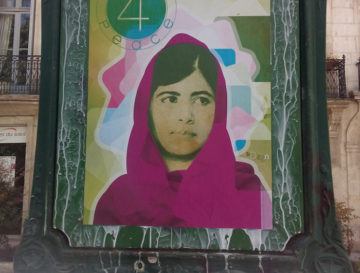Rafia Zakaria in The Baffler:
 MALALA YOUSAFZAI IS FREAKING OUT about the future. The now twenty-three year old says so in an interview given to British Vogue, which has featured her clad in a blood-red outfit with matching headscarf on its July cover. Inside is a luscious photo spread and the kind of cutesy confessions that one would expect from a woman sentenced to being a girl forever: she was not chosen as head girl at school, she confesses; she loved being at Oxford and ordering takeout whenever she pleased. In this interview, as in most others of the thousands she has given, the interviewer emphasizes her ordinariness; Malala likes to take selfies, we learn, and her standing order at McDonalds is a sweet chili chicken wrap and a caramel frappe. In these revelations is the assurance that Malala Yousafzai, the girl wonder who fought the Taliban, is still the innocent and monochromatic figure the world needs her to be.
MALALA YOUSAFZAI IS FREAKING OUT about the future. The now twenty-three year old says so in an interview given to British Vogue, which has featured her clad in a blood-red outfit with matching headscarf on its July cover. Inside is a luscious photo spread and the kind of cutesy confessions that one would expect from a woman sentenced to being a girl forever: she was not chosen as head girl at school, she confesses; she loved being at Oxford and ordering takeout whenever she pleased. In this interview, as in most others of the thousands she has given, the interviewer emphasizes her ordinariness; Malala likes to take selfies, we learn, and her standing order at McDonalds is a sweet chili chicken wrap and a caramel frappe. In these revelations is the assurance that Malala Yousafzai, the girl wonder who fought the Taliban, is still the innocent and monochromatic figure the world needs her to be.
An exception to this assessment, which may be worse, can be found in Pakistan. Over there, the need to counter the country’s reputation as the site of Malala’s cruel militant mauling in 2012 has produced a vicious desire to police her life and movements abroad. When a photo of Malala wearing skinny jeans made the rounds on social media a few years ago, the Pakistani right was only too willing to list in great detail all the ways in which she had failed her faith/country/tribe and so on. If the West wishes to see Malala as the perpetual brave girl, the Pakistani religious right wants to present her as a crafty woman, and an errant one at that. It makes sense, then, that Malala has not chosen, at least at the moment, to live in Pakistan, where her scars remind everyone of their shameful inability to protect a young girl who spoke out for girls’ rights to education.
Pakistan is in Malala’s past. The celebrity world of international renown, red carpets, and millions and millions of dollars for her Malala Fund NGO are her current reality. It’s the flip side of Pakistan, a realm that is particularly attuned to the framework of her story as a young Muslim girl shot in the head by rabid and bloodthirsty Muslim men. As the scholar Shenila Khoja-Moolji has noted, the enduring and all-encompassing strength of this narrative is such that the individual, even Malala herself, is erased from it.
More here.
